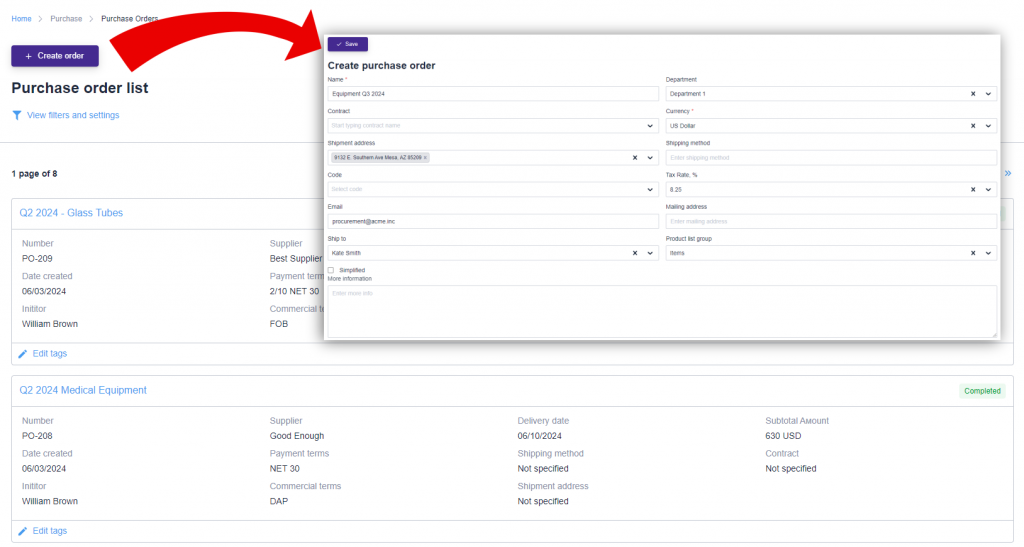Home » Notes & Thoughts » Maintaining Version Control of Purchase Orders

In the ever-evolving landscape of procurement, maintaining accurate and efficient version control of Purchase Orders (POs) is a critical task. Purchase Orders are fundamental documents that outline the terms of transactions between buyers and suppliers. They not only ensure that the correct products or services are delivered as agreed but also serve as binding legal contracts that protect both parties’ interests. However, as organizations grow and transactions become more complex, managing these documents effectively becomes a challenge.
Traditionally, businesses have managed Purchase Orders using paper documents, Word files, spreadsheets, and email communication. While these methods may seem straightforward, they present numerous challenges when it comes to version control.
Firstly, paper-based POs are prone to getting lost, damaged, or misfiled. If changes are made, tracking these alterations requires additional paperwork, making the process cumbersome and error-prone. Even when digital files like Word documents and spreadsheets are used, version control remains a significant issue. Multiple people may access, edit, and save over documents without a proper versioning system, leading to confusion over which version is the most recent or accurate. This lack of control can result in discrepancies that cause delays, misunderstandings, and even legal disputes if the incorrect version of a PO is acted upon.

Furthermore, email communication for PO approvals and revisions often leads to fragmented information, with different versions of the same PO scattered across multiple inboxes. This dispersion of data makes it challenging to consolidate and confirm the final agreed terms. The lack of a centralized system makes auditing and compliance difficult, as there is no single source of truth to reference. These traditional methods not only consume valuable time and resources but also expose organizations to risks of miscommunication, errors, and inefficiencies.
The advent of procurement software has been a game changer for managing Purchase Order version control, offering solutions that eliminate the shortcomings of traditional methods. With procurement software, businesses can centralize their PO management, ensuring all documents are stored in a single, secure repository. This centralized storage allows for real-time tracking of changes and provides a complete history of all versions of a Purchase Order. Users can see what changes were made, when they were made, and by whom, which enhances accountability.

One of the key benefits of procurement software is its ability to automate workflows and enforce approval hierarchies. This feature ensures that only authorized personnel can make changes to POs, and all modifications are automatically logged. Automated notifications and alerts keep relevant parties informed of updates or required actions, reducing delays and ensuring that POs are processed efficiently. Lower amount of manual work mistakes leads to cost savings because the company wastes less resources to combat the failures.
Another significant advantage is the improved collaboration facilitated by procurement software. Teams can work simultaneously on the same document, with changes being tracked and merged seamlessly. This real-time collaboration eliminates the versioning conflicts often encountered with traditional file-sharing methods and ensures that everyone is always working on the latest version of the PO.
Additionally, procurement software integrates seamlessly with other systems, such as accounting, ensuring that PO data is consistent and up-to-date across the organization. This integration minimizes manual data entry and the associated risk of errors, providing a more reliable and efficient procurement process.
Implementing procurement software for Purchase Order version control requires careful planning and execution. Organizations should start by assessing their current procurement processes and identifying areas where version control issues are most prevalent.

For example, Acquirell all-in-one procurement automation software offers a robust solution that enables the procurement team to gain full control over PO processing.

The managers may set up user roles, permissions, and approval workflows to ensure that the software enforces the desired level of control and accountability.
Maintaining version control of Purchase Orders is crucial for the efficiency, accuracy, and reliability of procurement processes. While traditional methods like paper documents and spreadsheets present significant challenges, the use of procurement software offers a robust solution that transforms how POs are managed. By centralizing data, automating workflows, and facilitating real-time collaboration, procurement software not only improves version control but also enhances overall procurement efficiency. For organizations seeking to streamline their procurement processes and mitigate risks, implementing procurement software is not just a step forward; it is a strategic necessity.
Book a demo to see how Acquirell can help the company to maintain the version control of Purchase Orders.
| Cookie | Duration | Description |
|---|---|---|
| cookielawinfo-checkbox-analytics | 11 months | This cookie is set by GDPR Cookie Consent plugin. The cookie is used to store the user consent for the cookies in the category "Analytics". |
| cookielawinfo-checkbox-functional | 11 months | The cookie is set by GDPR cookie consent to record the user consent for the cookies in the category "Functional". |
| cookielawinfo-checkbox-necessary | 11 months | This cookie is set by GDPR Cookie Consent plugin. The cookies is used to store the user consent for the cookies in the category "Necessary". |
| cookielawinfo-checkbox-others | 11 months | This cookie is set by GDPR Cookie Consent plugin. The cookie is used to store the user consent for the cookies in the category "Other. |
| cookielawinfo-checkbox-performance | 11 months | This cookie is set by GDPR Cookie Consent plugin. The cookie is used to store the user consent for the cookies in the category "Performance". |
| viewed_cookie_policy | 11 months | The cookie is set by the GDPR Cookie Consent plugin and is used to store whether or not user has consented to the use of cookies. It does not store any personal data. |